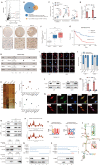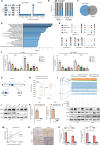N6-Methyladenosine-modified lncRNA LINREP promotes Glioblastoma progression by recruiting the PTBP1/HuR complex
- PMID: 35871232
- PMCID: PMC9883516
- DOI: 10.1038/s41418-022-01045-5
N6-Methyladenosine-modified lncRNA LINREP promotes Glioblastoma progression by recruiting the PTBP1/HuR complex
Abstract
Glioblastoma multiforme (GBM) is acknowledged as the most aggressive primary brain tumor in adults. It is typically characterized by the high heterogeneity which corresponds to extensive genetic mutations and complex alternative splicing (AS) profiles. Known as a major repressive splicing factor in AS, polypyrimidine tract-binding protein 1 (PTBP1) is involved in the exon skipping events of multiple precursor mRNAs (pre-mRNAs) in GBM. However, precise mechanisms that modulate the expression and activity of PTBP1 remain to be elucidated. In present study, we provided evidences for the role of a long intergenic noncoding RNA (LINREP) implicated in the regulation of PTBP1-induced AS. LINREP interacted with PTBP1 and human antigen R (HuR, ELAVL1) protein complex and protected PTBP1 from the ubiquitin-proteasome degradation. Consequently, a broad spectrum of PTBP1-induced spliced variants was generated by exon skipping, especially for the skipping of reticulon 4 (RTN4) exon 3. Interestingly, LINREP also promoted the dissociation of nuclear UPF1 from PTBP1, which increased the binding of PTBP1 to RTN4 transcripts, thus enhancing the skipping of RTN4 exon 3 to some extent. Besides, HuR recruitment was essential for the stabilization of LINREP via a manner dependent on N6-methyladenosine (m6A) formation and identification. Taken together, our results demonstrated the functional significance of LINREP in human GBM for its dual regulation of PTBP1-induced AS and its m6A modification modality, implicating that HuR/LINREP/PTBP1 axis might serve as a potential therapeutic target for GBM.
© 2022. The Author(s), under exclusive licence to ADMC Associazione Differenziamento e Morte Cellulare.
Conflict of interest statement
The authors declare no competing interests.
Figures








References
Publication types
MeSH terms
Substances
LinkOut - more resources
Full Text Sources
Other Literature Sources
Research Materials
Miscellaneous

